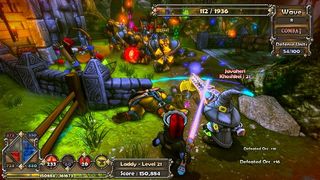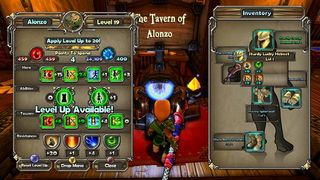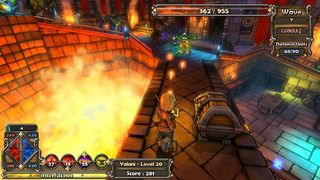Dungeon Defenders – hands-on
Cute kids become unlikely heroes in this Diablo-ish take on tower defense
The premise of Dungeon Defenders is an amusing one: young kids still within their respective apprenticeships of wizards or warriors are left alone to take care of their castle while the parents are away. What kind of parents leave children without adult supervision in a giant castle for extended periods of time? Apparently smart and stupid ones, because although the kids accidentally unleash an evil sleeping dormant in the castle basement, they are also incredibly capable at holding off entire armies of full-grown monsters. Hmm, maybe the whole thing is a test secretly conducted by the parents?

Above: The graphics are lush and colorful. Wait, is that a lightsaber?
Either way, Dungeon Defenders takes its cutesy premise and applies it to its art style but not necessarily its gameplay – its tower defense gameplaystructure seems to be surprisingly deep from what we played. A typical level goes like this: players choose their characters from the familiar templates of melee fighters, rogues, and spellcasters, and then there begins the setup phase, a time-limited segment where players spend resources to lay out their defenses. Once time runs out, the monster begin spawning, streaming toward the crystal in the center of the map, which if they succeed in destroying, it’s game over.
Building defenses is one half of the game’s core; the other is running around and directly defending chokepoints via the in-game avatar. So it’s a sort of hybrid tower defense and hack-and-slasher. With drop in/drop out four-player online co-op (also supporting full, four-player splitscreen or even a combination of splitscreen and online), the chaos can get intense, with everyone communicating to make sure every defense point is covered. To make things even more nerve-wracking, enemies come in waves, and with each successive wave the setup phase where you can build defenses gets shorter, so you have to hurry and scramble, and keep scrambling to build towers while fighting off the hordes.

Defenses come in several types, and are also dependent on what type of character is chosen. The first line of defense is the barrier, which does the obvious, but also adds extra effects – so for instance, one hero's barrier pushes enemies back when they touch it, while another hero's barrier has spikes that do damage. Typically players will build their towers behind the barriers, but there are many to choose from: some only fire in a narrow cone-shaped field of fire, while others, while not as powerful, can fire a full 360 degrees. Towers also fire all kinds of different projectiles, so picking the right ones for a task will be crucial.
The combat for the actual kiddie heroes is very simple so that it’s possible to juggle both fighting and building, but there will also be tons of loot to collect, and items themselves will be able to level up until they reach a certain power level, allowing playersto actually name them for a unique flavor. There will be online trading and sharing of items as well, so the game will be economy driven at least on some level.

Above: There will be customization up the wazoo
Sign up to the GamesRadar+ Newsletter
Weekly digests, tales from the communities you love, and more
The game takes place over successively higher levels of the castle as the monster swarms push the kids farther upward, and every few levels will have a crazy boss fight that has its own rules. We fought a demon-ish looking thingy that had a kind of magic force field protecting it, so in order to harm it we had to cooperate and take down laboratory machines before thrashing away at the boss, all the while facing swarms of monsters from all sides.
Dungeon Defenders looks like it will serve up a lot of game for being a downloadable title for a measly ten bucks, and the PS3 version even supports Move and 3D. The kid-friendly vibe might deter some hardcore gamers, but from what we saw it’s a pretty hefty tower defense experience. Dungeon Defenders currently aims for a fourth-quarter release this year, on PS3, PC, and 360.

Oct 11, 2010

An incredible XCOM-like strategy game is finally getting a sequel after 9 years - the latest in a criminally slept-on series that's never seen a bad game

The latest unexpected Steam hit is a $3 must-play and it may still hit greater heights after nearly 7,000 glowing reviews as the dev looks to add multiplayer
Most Popular



